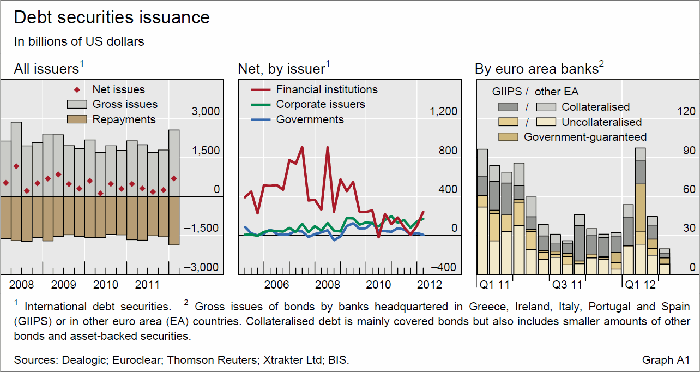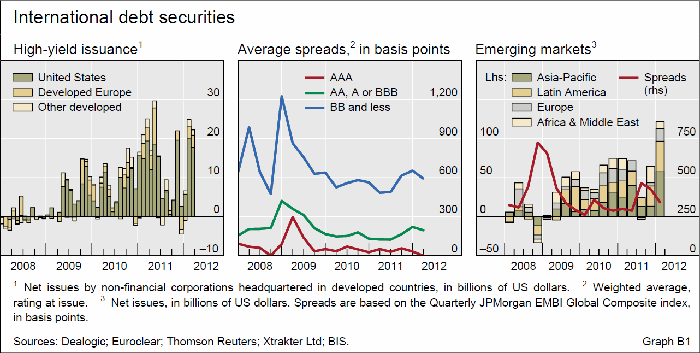International debt security issuance in the first quarter of 2012
(Extract from pages 20-21 of BIS Quarterly Review, June 2012)
Issuance of international debt securities picked up strongly in the first quarter of 2012. The rise was largely driven by the impact of the ECB's three-year collateralised LTROs (longer-term refinancing operations), which helped to avert a funding crisis in the European banking sector. By improving market confidence, the ECB's policy action was influential in reopening the primary markets for debt securities for euro area financial institutions.
Global gross issuance of international debt securities reached $2,562 billion, a 40% increase over the previous quarter (Graph A1, left-hand panel) and the strongest since Q2 2008. With repayments up by only 20%, to $1,865 billion, during the first quarter, net issuance of international debt securities climbed to $696 billion. This exceeds the amount of net issuance during the entire second half of 2011 ($428 billion).
Issuers headquartered in Europe were the most active borrowers during the period, raising $240 billion net, more than doubling the previous quarter's net borrowing. Borrowers of US nationality raised $97 billion net, also a notable increase relative to $57 billion during the final quarter of last year. Borrowers in emerging markets issued $122 billion net in international debt securities, the largest quarterly amount since the inception of the BIS statistics. International institutions (mostly multilateral development banks) also raised significant amounts worth $140 billion net.
The first quarter saw many financial corporations tapping international debt markets (Graph 5, centre panel). At $385 billion of net issuance, borrowing by financial corporations outstripped that by non-financial firms ($167 billion). European financial firms were particularly active, with $200 billion in net issues of international debt securities. In that market, US financial corporations borrowed much less ($17 billion net), whereas US non-financial corporations continued their trend of strong activity, raising $80 billion net.
Wholesale funding conditions for European banks eased considerably following the first of the ECB's three-year LTROs, in late December 2011. Overcoming their lockout from the market towards the end of 2011, European banks returned with a significant amount of debt issuance to take advantage of more benign market conditions.
Importantly, the composition of the newly issued debt by European banks changed (Graph 5, right-hand panel). For long periods in the second half of 2011, much of the debt issuance by European banks had been confined to covered bonds, as unsecured bond funding was available only for top-rated banks and banks headquartered in jurisdictions with a AAA sovereign credit rating. It was primarily high-rated European banks (such as ABN AMRO, Rabobank, Nordea and SEB) that reopened the market for senior unsecured bonds at the beginning of January. Lower-tier names and banks headquartered in peripheral countries followed suit and began to issue senior unsecured bonds.
Nevertheless, issuance in the senior unsecured segment was still fairly concentrated in banks from core euro area countries. Debt issuance by banks in non-core countries to a large extent still consisted of covered bonds and government-guaranteed bonds.
As investors demanded lower risk compensation and as sentiment improved after the ECB's first three-year refinancing operation, issuance activity in the high-yield bond market segment again picked up to satisfy investors' increased risk appetite (Graph B1, left-hand panel). Spreads in the high-yield segment had moved up towards the end of 2011 in the face of the uncertainty around the euro area sovereign debt woes, but they came down somewhat as sentiment improved at the beginning of the year (Graph B1, centre panel). Activity in the high-yield bond market was dominated by US corporations, which issued high-yield debt securities worth $44 billion after repayments, most of it in February and March.
Emerging market borrowing was also very strong (Graph B1, right-hand panel). Borrowers from Asia and the Pacific tapped international debt markets with $58 billion of net issues, most of it attributable to borrowers in China ($33 billion) and Korea ($9 billion). Borrowing from issuers headquartered in Latin America also rose, to $39 billion



